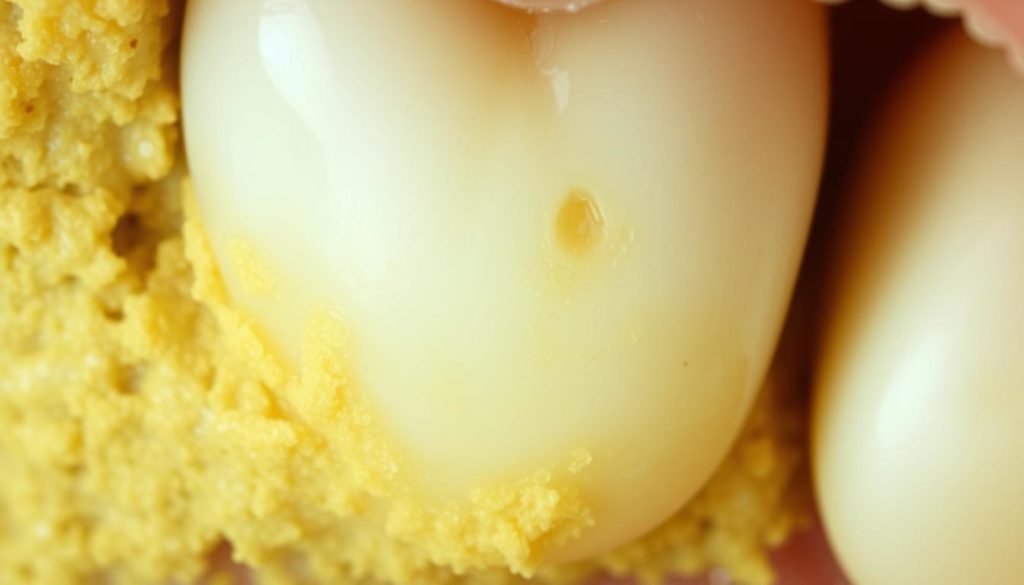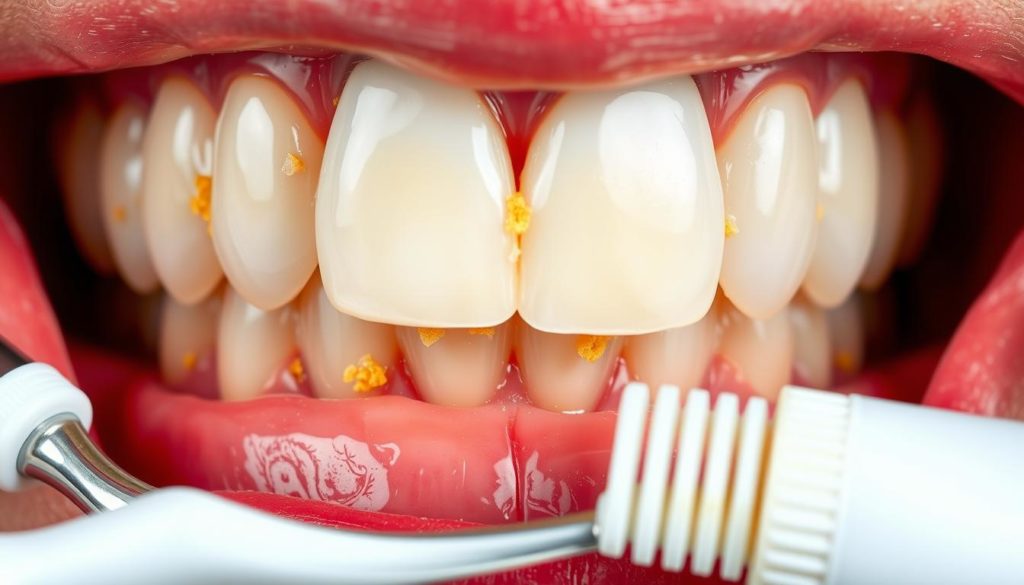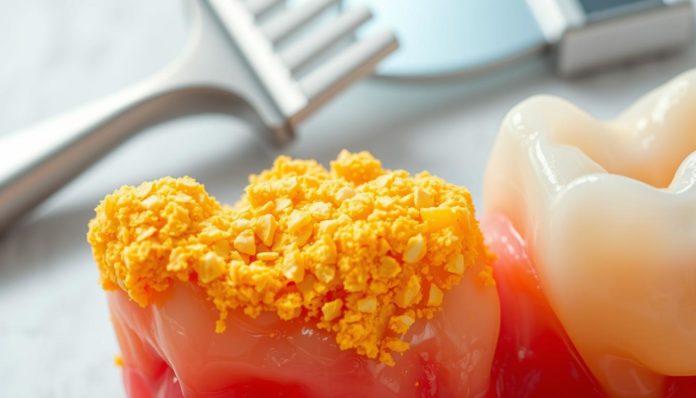A shocking 68% of adults have tartar on their teeth. This not only looks bad but also leads to cavities, gum disease, and even losing teeth. To keep your smile bright and your mouth healthy, you need to know how to tackle tartar.
Tartar, or calculus, happens when plaque on teeth hardens. Once tartar forms, only a dentist can remove it. But, you can stop tartar before it starts with good habits.
To fight off tartar, brush properly, use tartar control toothpaste, and floss each day. You might also consider some home or professional treatments. Follow these steps to keep your smile bright and healthy.
Understanding Dental Plaque and Tartar
In the journey to great oral health, it’s important to know the difference between plaque and tartar buildup. People often mix up these two dental issues. Let’s look closely at what sets them apart in dental care.

What is Dental Plaque?
Dental plaque is a sticky, soft layer that forms on your teeth. It contains bacteria, saliva, and food leftovers. If you don’t remove plaque regularly, it can cause tooth decay and gum problems. Brushing and flossing well after eating helps prevent plaque from harming your teeth.
How Tartar Forms from Plaque
If you don’t clean dental plaque off in time, it turns into tartar, also known as calculus. This change can happen in just one to three days. Tartar makes more tartar buildup likely because it’s rough and sticky, which is bad for your oral health.
Effects of Tartar on Oral Health
Tartar buildup can ruin your dental health. It messes up your smile and leads to worse oral health problems. Knowing how tartar affects you is key to keeping your mouth healthy and avoiding serious damage.

Tartar and Gum Disease
Tartar is closely linked to gum disease. The bacteria in tartar can make your gums swollen and inflamed. This can lead to gingivitis or periodontitis. Symptoms include gums that are red, swollen, and bleed easily. Without treatment, these issues can get really bad, like causing your gums to pull back or losing teeth.
Impact on Tooth Enamel
Tartar is tough on your tooth enamel. It creates a breeding ground for more plaque, which harms your enamel. This means you’ll need professional cleanings. It also shows why good oral hygiene is crucial to stop tartar from forming.
| Effect | Details |
|---|---|
| Gum Disease | Inflammation, bleeding, gum recession, tooth loss |
| Enamel Damage | Weakening of protective enamel, increased risk of cavities |
Effective Brushing Techniques
Optimal dental care includes knowing how to brush right. Many use hard, back-and-forth strokes mistakenly. This method can push plaque under the gums. Instead, gentle, circular motions should be used to remove plaque well.
Put the toothbrush at a 45-degree angle to better clean where gums and teeth meet. Brushing at least twice a day is key, especially for those prone to plaque. Doing so prevents tartar and keeps your teeth healthy.
Let’s look at the best brushing methods:
| Technique | Key Benefits |
|---|---|
| Circular Motions | Effective plaque removal; gentle on gums |
| Back-and-Forth Strokes | Less effective; can push plaque into gums |
| 45-Degree Angle | Targets gumline; better plaque removal |
Adding these brushing techniques to your routine promotes oral health and a brighter smile.
Choosing the Right Tartar Control Toothpaste
Finding the right tartar control toothpaste is key for a healthy smile. This toothpaste prevents hardened plaque buildup. Hardened plaque can lead to serious dental issues if not addressed. Look for key ingredients and get advice from your dentist to choose wisely.
Ingredients to Look For
A top tartar control toothpaste includes several important parts. Fluoride is known for making enamel stronger. Consider these essential ingredients:
- Fluoride: Helps to strengthen tooth enamel and fight cavities.
- Pyrophosphates: Inhibit the formation of tartar above the gum line.
- Triclosan: An antibacterial agent that reduces bacteria in the mouth.
Recommendations from Dentists
Dentists recommend certain tartar control toothpastes based on your dental needs. They suggest looking for dentist-approved toothpastes. Brands like Colgate and Crest are trusted for their tartar control formulas. They recommend fluoride toothpastes and the right way to brush for the best care.
| Brand | Key Ingredient | Recommended Use |
|---|---|---|
| Colgate Total | Triclosan & Fluoride | Twice daily brushing |
| Crest Tartar Protection | Pyrophosphates & Fluoride | Twice daily brushing |
| Arm & Hammer Peroxicare | Baking Soda & Fluoride | Twice daily brushing |
Mixing the top tartar control toothpaste with regular dentist visits is vital. Dentist advice helps tailor products to your oral health needs. This improves your daily care and leads to a healthier, cleaner smile.
The Role of Flossing in Preventing Tartar
Flossing is key for great dental hygiene. It reaches between teeth, removing food and bacteria. This prevents tartar from forming.
Make flossing a daily habit. It gets rid of plaque that can turn into tartar. This keeps cavities and gum disease at bay, protecting your teeth.
- Removes food particles that toothbrushes miss.
- Helps prevent cavities by reducing plaque.
- Minimizes the risk of gum disease by cleaning below the gum line.
- Supports overall dental hygiene by keeping gums healthy.
See how flossing and brushing together make a difference:
| Aspect | Brushing Alone | Brushing with Flossing |
|---|---|---|
| Plaque Removal | Moderate | High |
| Prevents Tartar Buildup | Limited | Significant |
| Reduces Risk of Gum Disease | Moderate | High |
| Overall Dental Hygiene | Moderate | Excellent |
Adding flossing to your daily oral care is a key move. It helps fight tartar and keeps your smile healthy.
Home Remedies for Tartar Removal
Natural ways to clean tartar can boost your regular tooth care. Simple at-home tricks keep your smile bright and healthy.
Using Baking Soda
Baking soda is great for fighting mouth acids. Make a paste with some water and brush your teeth with it. It clears tartar and whitens your teeth. But, use it sparingly to keep your enamel safe.
White Vinegar Solution
White vinegar fights germs and stops infections. Mix a tablespoon of it with warm salt water. Gargle daily to fight tartar and keep your mouth healthy.
Rubbing Orange Peels
Orange peels, full of vitamin C, fight germs well. Rub the inside of a peel on your teeth. It removes tartar and freshens your breath. It’s a great addition to your tooth care.
Exploring Professional Tartar Removal Methods
Dealing with hardened calculus often calls for professional help. Regular dental cleanings are a must every six months. They are key in removing tartar that home brushing can’t get rid of.
Dental Cleanings
Dental cleanings play a big role in keeping your mouth healthy. They stop tartar from building up. Dentists use special tools to remove tartar, especially in tough spots. This helps prevent gum diseases and keeps teeth decay at bay.
Scaling and Root Planing
For those with lots of tartar and gum disease, scaling and root planing are next steps. Scaling gets rid of tartar above and below the gum line. Root planing smooths the teeth’s roots for the gums to reattach. This can stop gum disease from getting worse.
Knowing why you need professional tartar removal is crucial for your dental health. Using these methods regularly can fend off serious dental issues. It keeps your oral health on track.
Diet and Lifestyle Tips to Reduce Tartar Buildup
Eating well and staying active are key for good oral health. Choose your foods wisely to help lower tartar buildup.
Effect of Sugary Foods and Drinks
Sugary treats and drinks lead to dental plaque, turning into tartar. Cut down on these to fight tartar buildup. Eating less sugar is crucial for healthy teeth.
Importance of Hydration
Staying hydrated is important for your mouth’s health. Drinking lots of water cleans away food bits and fights bacteria’s acids. It helps prevent plaque and tartar, keeping your mouth clean and healthy.
| Dietary Tips | Benefits for Oral Health |
|---|---|
| Reduce Sugary Foods | Minimizes plaque formation and decreases risk of tartar buildup |
| Stay Hydrated | Washes away food particles and neutralizes harmful acids |
| Balanced Diet | Supports overall oral health and prevents dental problems |
Using Dental Picks and Electric Plaque Removers
Dental picks and electric plaque removers are key for good oral health. They help remove plaque and tartar. Using these tools can make your smile cleaner and healthier.
How to Safely Use a Dental Pick
Choosing a comfortable dental pick is the first step. Insert it gently between your teeth and scrape away from the gums. Be gentle and use a mirror to see better. Dental picks are great for reaching plaque that brush can miss.
Benefits of Electric Plaque Removers
Electric plaque removers have many benefits. They come with different heads for various plaque issues. They work better at breaking down plaque than manual tools.
These devices reduce tartar risk. Many have built-in timers for a thorough clean.
Regular Dental Checkups for Tartar Control
Going to the dentist often is key to keep your mouth healthy and to control tartar. At an oral examination, they spot early plaque. They take action before it turns into hard tartar. Catching these signs early helps avoid bigger tooth problems later.
When you visit your dentist, they can clean your teeth well. This cleaning is called scaling or prophylaxis, and it’s something you can’t do alone at home. Dentists use special tools and knowledge to get rid of tartar. This helps keep your teeth and gums healthy for a long time.
Being proactive is essential to prevent tartar from hurting your teeth. In these visits, your dentist can offer tips on keeping your teeth clean. They may also suggest products like tartar-control toothpaste. Regular checkups and professional cleanings are crucial. They are the core of fighting tartar and protecting your oral health.
FAQ
What is dental plaque?
Dental plaque is a sticky film on your teeth. It’s made of bacteria, food particles, and saliva. If not cleaned well, it can lead to tooth decay and gum disease.
How does tartar form from plaque?
Tartar forms when plaque on your teeth hardens. This happens if plaque isn’t cleaned off. Tartar creates a rough surface that can lead to more oral health issues.
Can tartar lead to gum disease?
Yes, tartar can cause gum diseases like gingivitis. These diseases make your gums red, swollen, and bleed. If not treated, they can lead to tooth loss.
How does tartar affect tooth enamel?
Tartar damages tooth enamel. It makes a rough surface that attracts more bacteria. This can lead to cavities and weaken your teeth over time.
What are effective brushing techniques to prevent tartar buildup?
To prevent tartar, use circular brushing motions. Keep your toothbrush at a 45-degree angle to your gums. Brushing twice a day is also important.
What should I look for in tartar control toothpaste?
Choose a tartar control toothpaste with fluoride. Fluoride makes your enamel stronger. Your dentist might suggest specific brands for you.
How does flossing help in preventing tartar buildup?
Flossing gets rid of plaque and food in spaces your brush can’t reach. This stops plaque from hardening into tartar. It’s key for fighting cavities and gum disease.
Are there any home remedies for tartar removal?
Yes, things like baking soda paste or vinegar can help with tartar. But, these should add to, not replace, visits to the dentist and daily brushing and flossing.
What are professional tartar removal methods?
Dentists use cleanings, scaling, and root planing to remove tartar. These are special treatments for tartar that’s too hard to be cleaned by brushing and flossing alone.
How does diet affect tartar buildup?
What you eat affects tartar. Sugary stuff increases plaque, leading to tartar. Drinking plenty of water helps clean your mouth and lowers tartar risk.
How do I safely use a dental pick?
Be gentle with a dental pick to keep your enamel and gums safe. Always follow the advice of dental pros and the pick’s instructions.
What are the benefits of electric plaque removers?
Electric plaque removers are great. They come with different heads for various needs and can clean better than manual brushing. Still, use them as your dentist advises.
Why are regular dental checkups important for tartar control?
Dental check-ups catch plaque early and clean it before it turns to tartar. Staying ahead keeps your mouth healthy and prevents tartar problems.


